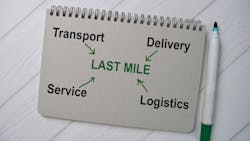Pandemic impact on suppy chain relationships
The pandemic has changed the ways shippers and 3PLs connect with last-mile transportation providers. Many shippers and third-party logistics (3PL) companies formed new strategic partnerships in the face of these changes to combat same-day delivery expectations fueled by the “Amazon Effect” during lock-down.
That was the conclusion of a new whitepaper entitled The Age of Amazon: Why 3PLs & Last-Mile Delivery Fleets Must Draw Closer. The whitepaper is a joint project of the Customized Logistics & Delivery Association (CLDA), the trade association for final-mile delivery companies, and the Transport Intermediaries Association (TIA), the voice of the 3PL industry.
“The final-mile logistics is an important relationship for our members and is a multi-billion-dollar industry that plays an integral role in the supply-chain," Anne Reinke, CEO of TIA, noted. “We brought together the expertise of the two associations’ members as well as industry analysts to highlight that relationship and to pinpoint trends where 3PLs and last-mile delivery providers can join together to compete against Amazon’s market dominance.”
The research identifies four areas where these two players in the supply chain can and have worked together to meet the increasing demands of consumers.
Ecommerce: With people spending more time at home during the pandemic, online sales increased by 44% in 2020 to reach 21.3% of total retail sales. Delivery of heavy goods purchased through e-commerce channels is an area of opportunity the whitepaper cites for fleets that can meet specialized delivery requirements such as setup and reverse logistics for items such as medical devices, exercise, and home office equipment.
Medical lab logistics: Laboratory tests for blood and tissue samples are conducted 13 billion times a year in the United States and have time-sensitive and specialized handling and delivery requirements. Last-mile providers have seen their medical business increase significantly during the COVID-19 pandemic, including work transporting vaccines with hospital networks.
B2B: Freight opportunities in the B2B last-mile sector abound for pallet-sized LTL freight and heavier items that have unique service requirements such as after-hour deliveries to business and residential customers. These are best met by a combination of 3PL and last-mile providers. Motor carriers and 3PLs are chasing opportunities in the last-mile of this sector to offer blended warehousing and delivery services that smooth order fulfillment for customers that experienced supply chain disruptions from COVID-19.
Special projects: Last-mile fleets that operate facilities near large urban centers, like New York City, are seeing demand increase from shippers, 3PLs, and motor carriers to utilize their local delivery services. These customers are dropping off large-volume truckload and LTL shipments at their docks. Last-mile carriers separate volume loads into smaller shipments and make urban deliveries on repeat schedules, such as distributing shipments to retail stores.
Drawing on the expertise of industry analysts and members of both associations, the whitepaper also identified a number of additional facts about the supply chain:
- In the United States, approximately 15,000 registered 3PLs generate about $90 billion in annual revenue primarily by managing truckload and LTL freight transactions.
- The fourth quarter of 2020 was the strongest in the history of the last-mile segment.
- Last-mile fleets serviced 21% more stops in 2020 than in 2019.
- Much of the growth came after the April 2020 pandemic dip to reach a total of one-half billion delivery stops by year’s end across more than two dozen industry sectors.
- Overall, the last-mile delivery market in North America is expected to reach $44.88 billion from 2020 to 2024 at a compound annual growth rate of over 14%.
- Amazon continues its dominance as the world’s largest third-party logistics (3PL) provider, reaching 60% market share in the U.S.
- Amazon currently delivers to 72% of all Prime customers within 24 hours.
This article originally appeared on MH&L.
